An example of calculating sewage slope: formulas and technological standards
Sewerage system is a network of pipelines, functional units, modules and standard components. The whole set is designed to ensure unhindered passage of wastewater. It is obvious that spontaneous movement of household wastewater in pipes is possible if the slope was observed during their laying.
From the article we have proposed, you will learn how to calculate the slope of the sewage system. After all, this is not an arbitrary value: the slope should ensure the movement of effluents at the speed necessary for the normal operation of the system. We will describe how an important parameter for sewage is determined.
The content of the article:
Sewer network device: rules and regulations
Installation of household and any other sewage system is quite clearly explained by SNiP. Moreover, the explanations available in the documents are the norms and rules that professional builders strictly observe.
DIY construction, of course, is difficult to equate to professional activities. But this moment does not remove the installation obligations from the home master. Therefore, it is recommended that each builder know how to calculate the sewage system.

It would seem, why go into all the intricacies of the calculations? Is anything really going to change dramatically in the sewage system if we make the pipe slope a little less or a little more than the existing SNiP parameters?
So, the practice of operating communications shows: even small deviations of the slope values from the established norms can disrupt the normal operation of the sewage system.
For example, the owner of a private house makes a sewer with his own hands and does not own the calculation method. He takes and lays the slope of the pipelines “by eye”.As a result, the slope value of household sewage is less than the normative figures.

The speed of movement of the economic and fecal environment decreases, at first insignificant congestion forms, followed by massive, difficult to break through. Finally, the line is completely clogged; the task of global cleaning is on the agenda. And such a system operation, with insufficient slope of the pipes, promises an enviable constancy of congestion and unpleasant odors.
Another point: an unprofessional master mounts the sewer at a slope that exceeds the normative figures. The oversized slope of the sewage pipelines increases the speed of the liquid medium, but at the same time the so-called "separation effect" is formed.
Fluid flowing above the self-cleaning rate is separated from the solid mass that remains on the pipe walls. Over time, the residual masses increase, and the same result is obtained - congestion, odors, cleaning.
Correctly set slope values are the key to a long and reliable system operation.
About the calculation of sewer networks
The speed of movement of the economic and fecal environment, at which the self-cleaning effect is achieved, is mathematically calculated by the formula:
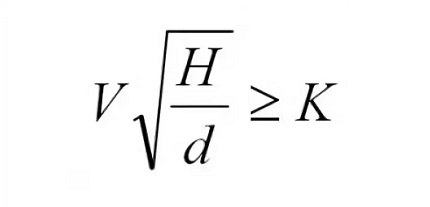
Designations:
- V - velocity of the liquid medium, (not less than 0.7 m / s);
- H / d - occupancy rate of the sewer pipe (not less than 1/3 of the volume);
- K - resistance coefficient, depending on the material of the pipeline (0.5 - plastic, glass; 0.6 - others).
The workshop of household and industrial sewage systems allows situations when the conditions calculated by the specified formula cannot be fulfilled due to the low consumption of sewage.
In this case, it is recommended to install communications from pipes with a diameter of up to 50 mm with a slope of 3 mm per 1 meter of length. Pipelines with a diameter of 85 - 100 mm are laid in compliance with a slope of 2 mm per 1 meter of length. In any case, the maximum allowable value of the slope norm can be 15 mm per meter of length, but no more.
If a channel mechanism for transporting sewage is used in the sewer system, there is also a standard for this case. So, the level of filling the trays should not exceed 0.8 the size of their height. The width of the sewer tray can not be less than 200 mm.
Moreover, the width of the tray is set based on the calculation of the hydraulic properties of the system and the design features of this element. So, sewer trays with a height of more than 500 mm in width should not be less than 700 mm.
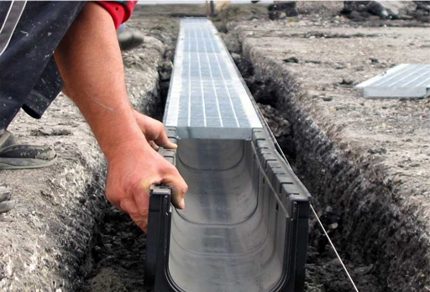
Trays in the construction of sewers are used in the construction of storm and drainage systems. With calculation drainage pipe slope will familiarize you with an article that we highly recommend reading.
Wastewater, filled with a high content of mechanical suspensions, is discharged along sewage lines made with a slope, the value of which is also determined by calculation, taking into account the provision of self-cleaning fluid velocity in the pipes.
Filling of pipelines is normalized by the value 1/3 of their volume. Typically, this type of effluent refers to industrial products, where particles of metals and other solid substances are mechanical suspensions.
Other norms (rules) of installation
The provisions of the regulatory documentation affect both the characteristics of the equipment involved in the sewer system, and the nuances of the installation itself.
Closed Communications Equipment
For most cases of designing domestic sewer communications, norms (rules) provide for the execution of closed pipelines. Such a scheme traditionally works on the principle of the movement of household and fecal waters by gravity.
At some facilities (usually industrial), where wastewater is discharged without odors and hazardous fumes, it is permissible to carry out communications based on gravity trays. In this case, it is required to equip the tray lines with a water lock device.
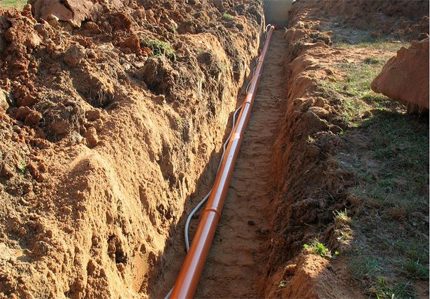
If we consider the system in plan, then each individual section sewer communications mounted strictly rectilinearly. If it is required to change the laying direction of pipelines, standard mounting components are used (corners, crosses, tees, transitions, etc.).
It is unacceptable to change the calculated values of the slope of the sewer pipelines in a separate section of the completed line, mounted in a horizontal position.
Which pipes are suitable for the system?
In relation to sewage networks (domestic, industrial), as well as with emphasis on the properties of corrosion resistance and strength, various modifications of pipes are used for the installation of sewage.
For communications made on the principle of gravity, pipe materials are:
- polymer compounds;
- cast iron;
- concrete;
- glass;
- asbestos cement.
Criteria and selection rules pipes for external sewage given here. The information recommended by us will be useful to all the zealous owners of suburban areas planned for construction.
Under communications, transporting liquids with pressure, pipes are made of materials:
- polymers;
- cast iron;
- asbestos cement;
- reinforced concrete.
Sewer lines of internal action are mounted in one of two ways: open / hidden. Regardless of the installation method, polymer pipes are widely used in installation. With landmarks of choice best sewer pipes will familiarize us with the article recommended by us.
Sewer pipelines made of plastic may be laid in the ground below the floor level of buildings. But you should take into account the load per site with such communications.
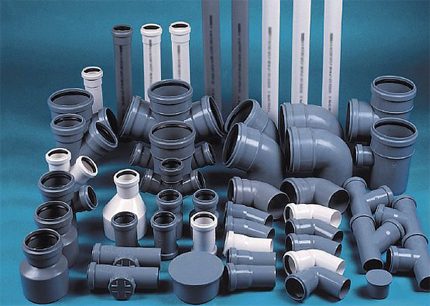
Plastic fittings are considered as universal, can be successfully used for internal and external networks.
Features of the installation of risers
Installation of risers inside residential buildings is done in canals, mines, boxes. Their design must comply with fire safety regulations. Mines, ducts, channels, etc., are necessarily equipped with removable panels.
Through the removal of panels provides access to communications. The use of removable panels made of materials capable of burning is allowed if the sewage line consists of polyvinyl chloride pipes. Panels of shafts where polyethylene pipes are laid are usually made of fireproof materials.
Open and closed lines
Installation of open sewer pipelines made of plastic is allowed to be carried out inside the attic areas of residential buildings, as well as in areas of basements.
The places where the sewer risers move from the living area to the attic area must be covered with a cement mortar with a thickness of at least 20-30 mm. The same mixture protects the pipe area above the overlap level by 80-100 mm, and before sealing with cement, a waterproofing material is applied to the surface of the pipeline.
Laying of internal sewer lines is prohibited in the structure of floors, inside walls, in the ceiling area of housing stock rooms. A number of buildings and premises for other purposes fall under the same requirements, where a special sanitary regime is provided.
If it is necessary to lay an outlet pipe from the sink of the bathtub or kitchen sink, this is done above the floor with the use of waterproofing, followed by facing the installation area.

The combination of domestic and industrial sewers is not allowed if industrial effluents contain liquids of a toxic nature or flammable.Sewer networks of any type, the scheme of which provides for the discharge of wastewater to the external sewage system, should be equipped with ventilation risers.
Upper trailer ventilation pipes it is necessary to withdraw through the thickness of the roof and raise to a height:
- For flat roofing (at least 300 mm).
- For pitched roofing (at least 500 mm).
The distance in the horizontal direction from the outlet of the riser to the nearby windows and balconies of the building should be at least 4 meters.
Sewer pipe laying
Gasket sloped sewer - this is only part of the requirements for the general laying of the sewer network. You should also take into account the norms established for the laying of pipes, based on the risks of damage and destruction.
These standards are due to temporary and permanent loads on communications. For example, for domestic conditions, the laying of sewer pipes inside buildings is performed to a depth of at least 100 mm, if we take the surface of the floor and the upper outer wall of the sewer pipe as measurement points.
Pipelines domestic sewagemounted in places of possible mechanical influences, it is recommended to protect by restricting direct access to them. For these purposes, protective nets, trays, channels, etc. are used.
If the pipeline is below the level of seasonal freezing of soil strata, technology should be applied sewer pipe insulation. Rigid polyurethane foam quite claims to be the role of modern insulation. Also, sewer pipes are insulated with mineral wool with preliminary waterproofing.
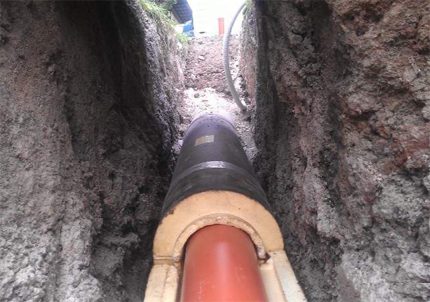
When a trench acts as a place for laying communications, after developing one with an estimated slope and before laying pipes, it is recommended to perform soil compaction. Soil compaction works are carried out on the area of the bottom of the trench along its entire length.
Soil compaction is required at least 200-300 mm in depth. After carrying out these measures, gravel is poured into the trench with an estimated slope or trays are laid and sewer pipes are already placed in the trays.
Conclusions and useful video on the topic
Interesting and informative reflections on the correct slope of the sewer pipe:
The organization of household waste water is not as simple a thing as an inexperienced layman can imagine. Professionals in the field of housing and household communications know: it is necessary to calculate the laying of sewer networks in each case of their construction, regardless of whether installation is carried out for a private house or an industrial system is being installed.
Please write comments, ask questions, post photos in the block below. Tell us about how sewer lines were laid in your own suburban area, did you comply with the standard deviation. It is possible that your tips will be useful to site visitors.

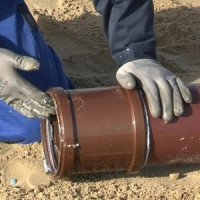 PVC pipes for outdoor sewage: types, sizes, advantages and disadvantages
PVC pipes for outdoor sewage: types, sizes, advantages and disadvantages 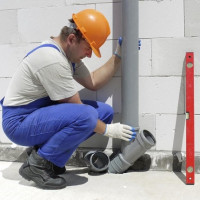 Wiring of sewers in a private house: drawing up a diagram and a project + stages of work
Wiring of sewers in a private house: drawing up a diagram and a project + stages of work 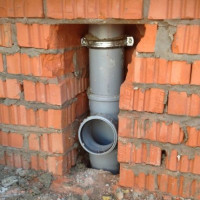 Sewerage ventilation in a private house: schemes and design rules
Sewerage ventilation in a private house: schemes and design rules 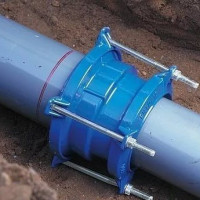 Cast iron pipes for outdoor sewage: types, features of application and installation
Cast iron pipes for outdoor sewage: types, features of application and installation 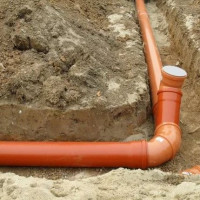 Sewer pipes for outdoor sewers: types and overview of the best brands
Sewer pipes for outdoor sewers: types and overview of the best brands  Sewerage flushing: pipe cleaning methods + main causes of blockages
Sewerage flushing: pipe cleaning methods + main causes of blockages  How much does it cost to connect gas to a private house: the price of organizing gas supply
How much does it cost to connect gas to a private house: the price of organizing gas supply  The best washing machines with dryer: model rating and customer tips
The best washing machines with dryer: model rating and customer tips  What is the color temperature of light and the nuances of choosing the temperature of the lamps to suit your needs
What is the color temperature of light and the nuances of choosing the temperature of the lamps to suit your needs  Replacement of a geyser in an apartment: replacement paperwork + basic norms and requirements
Replacement of a geyser in an apartment: replacement paperwork + basic norms and requirements